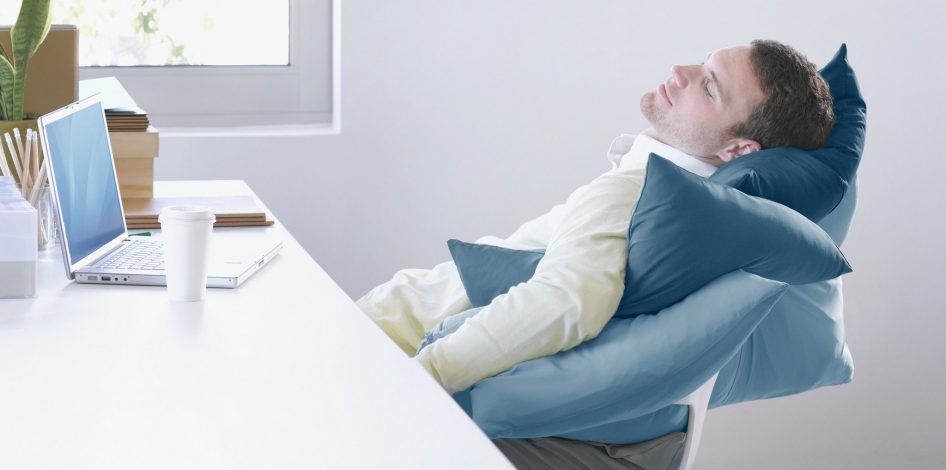
Take Naps at Work. Apologize to No One.
In the past two weeks I’ve taken three naps at work, a total of an hour or so of shut-eye while on the clock. And I have no shame or uncertainty about doing it. I couldn’t feel better about it, and my productivity reflects it, too.
Sleeping on the job is one of those workplace taboos — like leaving your desk for lunch or taking an afternoon walk — that we’re taught to look down on. If someone naps at 2 p.m. while the rest of us furiously write memos and respond to emails, surely it must mean they’re slacking off. Or so the assumption goes.
Restfulness and recharging can take a back seat to the perception and appearance of productivity. It’s easier to stay on a virtual hamster wheel of activity by immediately responding to every email than it is to measure aggregate productivity over a greater period of time. But a growing field of occupational and psychological research is building the case for restfulness in pursuit of greater productivity.
“Companies are suffering from tremendous productivity problems because people are stressed out” and not recovering from the workday, said Josh Bersin, principal and founder of Bersin by Deloitte. “They’re beginning to realize that this is their problem, and they can’t just say to people, ‘Here’s a work-life balance course, go teach yourself how to manage your inbox,’ ” Mr. Bersin said. “It’s way more complicated than that.”
To be sure, the ability to nap at work is far from widespread, experts said. Few among us have the luxury of being able to step away for a half-hour snoozefest. But lunch hours and coffee breaks can be great times to duck out, and your increased productivity and alertness will be all the evidence you need to make your case to inquiring bosses.
In an ideal world, we’d all solve this problem by unplugging early and getting a good night’s sleep. Here’s our guide on how to do just that. But the next best thing is stealing away for a quick power nap when you’re dragging after lunch.
(The Japanese even have a word for strategically sleeping on the job: “inemuri,” roughly translated to “sleeping while present.” Now is a good moment to pause and email this story to your boss.)
In a study published in Nature Neuroscience, researchers tested subjects on their perceptual performance four times throughout the day. Performance deteriorated with each test, but subjects who took a 30-minute nap between tests stopped the deterioration in performance, and those who took a 60-minute nap even reversed it.
“Naps had the same magnitude of benefits as full nights of sleep if they had a specific quality of nap,” said Sara Mednick, a co-author of the study and associate professor of psychology at the University of California, Riverside.
Dr. Mednick, a sleep researcher and the author of “Take a Nap! Change Your Life,” said daytime napping can have many of the benefits of overnight sleep, and different types of naps offer specific benefits.
For example, Dr. Mednick said a 20- to 60-minute nap might help with memorization and learning specific bits of information. It’s just long enough to enter stage-two sleep, or non-rapid eye movement (R.E.M.) sleep.
After 60 minutes, you start getting into R.E.M. sleep, most often associated with that deep, dreaming state we all enjoy at night. R.E.M. sleep can improve creativity, perceptual processing and highly associative thinking, which allows you to make connections between disparate ideas, Dr. Mednick said. Beyond that, your best bet is a 90-minute nap, which will give you a full sleep cycle.
Any nap, however, can help with alertness and perception and cut through the general fog that creeps in during the day, experts said.
So how did we even arrive at this point where aptitude is inextricably tied to working long, concentrated hours? Blame technology, but think broader than smartphones and laptops; the real issue is that tech has enabled us to be available at all times.
“We went through a period where people were in denial and business leaders were ignoring it,” Mr. Bersin said. “They were assuming that if we give people more tools, more emails, more Slack, more chatter, and we’ll just assume they can figure out how to deal with it all. And I think they’ve woken up to the fact that this is a big problem, and it is affecting productivity, engagement, health, safety, wellness and all sorts of things.”
It isn’t just office workers who can benefit from an afternoon siesta. A 2015 study published in Current Biology looked at the sleeping habits of three hunter-gatherer preindustrial societies in Tanzania, Namibia and Bolivia.
“They’re active in the morning, then they get in the shade under the trees and have a sort of quiet time, but they’re not generally napping,” said Jerome Siegel, professor of psychiatry and biobehavioral sciences, and director of the U.C.L.A. Center for Sleep Research, a co-author of the study. “Then they do some work and go to sleep, and they sleep through the night.”
Still, Mr. Siegel said the only genuine way to solve daytime sleepiness and fatigue starts the night before with a solid night’s sleep. The real Holy Grail of restfulness is a regular sleep schedule with ideally seven or eight hours of sleep each night, which experts say is optimal.
“Daytime napping certainly does increase alertness,” Mr. Siegel said. “But it’s not as simple as going to the gas station and filling the tank.”
He also advises avoiding caffeine late in the day and waking around the same time every morning, even if you can’t get to sleep at the same time every night. This helps acclimate your body to your regular wake-up time, regardless of how much sleep you got the night before.
So if you’ve made it this far and you’re interested in giving workday naps a try (or just starting to nod off), here’s a quick guide to the perfect nap:
• Find a quiet, unoccupied space where you won’t be disturbed.
• Try to make your area as dim as possible (or invest in a sleep mask you can keep in the office). Earplugs might help, too.
• Aim for around 20 minutes. Any longer than that and you’re likely to wake up with sleep inertia, which will leave you even groggier than before.
Terug naar nieuwsoverzicht